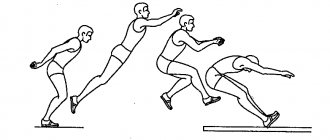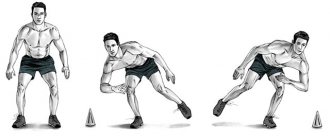© Daxiao Productions - stock.adobe.com
Share:
Shuttle running is a type of cardio exercise widespread throughout the world, aimed at developing the speed and strength qualities of an athlete. When performing a shuttle run, the athlete must run the same distance in the forward and reverse directions several times with a 180-degree turn at the end point of the distance. The most popular technique among athletes is shuttle running 10x10, 3x10.
Running 10 km standards for men and women
10 km running is a long distance athletics discipline. It can be carried out in a stadium, highway and rough terrain. Included in the Olympic Games since 1912, and for women since 1988.
Men's 10 km running standards
| Titles, ranks | Youth | ||||||||
| View | MSMK | MS | KMS | I | II | III | I | II | III |
| At the stadium (400 m lap) 10 km | 28:06,0 | 29:25,0 | 30:35,0 | 32:30,0 | 34:40,0 | 38:00,0 | — | — | — |
| By highway 10 km | — | — | — | 32:50,0 | 35:00,0 | 38:20,0 | — | — | — |
Women's 10 km running standards
| Titles, ranks | Youth | ||||||||
| View | MSMK | MS | KMS | I | II | III | I | II | III |
| At the stadium (400 m lap) 10 km | 32:00,0 | 34:00,0 | 35:50,0 | 28:20,0 | 41:30,0 | 45:00,0 | — | — | — |
| By highway 10 km | — | — | — | 38:40,0 | 41:50,0 | 45:20,0 | — | — | — |
Benefits and harms
Now you know how to quickly run a 10x10 shuttle run and where to start learning the correct technique. We also examined in detail what shuttle running distances are - by the way, the execution technique is no different for long or short runs. And now, we will tell you how shuttle running is beneficial for the human body:
- It perfectly develops dexterity;
- Helps improve speed in all other disciplines;
- Qualitatively saturates the blood with oxygen;
- Forms correct breathing technique;
- Promotes weight loss;
- Stimulates brain activity, because the athlete must calculate his actions several steps in advance;
- The mobilization of forces is activated, which affects the development of endurance.
Is it possible to harm yourself while doing this sport? If you study well how to learn shuttle running, follow all safety precautions and have no contraindications for health reasons, such exercises will not bring you any harm. Exercise for your health!
We hope you understand what shuttle running looks like and probably remember how you passed its standards more than once at school. If you regularly go for a run, we recommend that you include this type of race in your weekly program, along with interval and long sprints. This way you will be able to increase your results, regardless of your goals.
10 km running record
The world record in the 10 km race among men belongs to the Ethiopian Kenenisa Bekele, who ran this distance around the stadium in 26:17.53 m in Brussels in 2005.
In road running, the world record belongs to the Kenyan Leonard Komon, who covered 10 km in 26:44 in Utrecht in 2010.
The world record holder among women is Ethiopian Almaz Ayana, her result at the Rio Olympics in 2020 at the stadium was 29:17:45 m.
In road running, the world record is held by Englishwoman Paula Radcliffe. Her result was 30.21 m, which was recorded in 2003 at the London Marathon.
Features of the school program
The school program is designed for the comprehensive development of children . The shuttle running technique is one of the mandatory standards that is taken twice a year. To determine a child's progress , a complex calculation system created by the Ministry of Education is used.
It is very important to teach your child to run correctly. The coach determines the passing of the standard based on a set of indicators: the student’s exact age, gender and current level of physical development are taken into account.
Also, assessment categories differ significantly depending on the distance the student will cover. The school program includes races of length 3×10, 4×9 and 10×10 m. The first number is the number of segments, the second number is their length. When taking the races, schoolchildren will run the following distances: 3 times 10 m, 4 times 9 m or 10 times 10 m. The exact choice of distance depends on the class and age of the children.
Distance 3×10 m
Schoolchildren aged 7 to 17 years must run the 3x10 m standard. This is a standard race that is held regardless of passing other standards. The table below provides detailed numbers according to age and fitness level (from low to high). The standards are indicated separately for boys and separately for girls:
| Age | Level of development of the CS | ||||
| short | below the average | average | above average | high | |
| Boys | |||||
| 7 | 11.2 and more | 11,1-10,9 | 10,8-10,3 | 10,2-10,0 | 9.9 and less |
| 8 | 11,4 —//— | 10,3-10,1 | 10,0-9,5 | 9,4-9,2 | 9,1 —//— |
| 9 | 10,4 —//— | 10,3-10,0 | 9,9-9,3 | 9,2-8,9 | 8,8 —//— |
| 10 | 9,9 —//— | 9,8-9,6 | 9,5-9,0 | 8,9-8,7 | 8,6 —//— |
| 11 | 9,7 —//— | 9,6-9,4 | 9,3-8,8 | 8,7-8,5 | 8,4 —//— |
| 12 | 9,22 —//— | 9,1-9,0 | 8,99-8,5 | 8,4-8,3 | 8,2 —//— |
| 13 | 9,3 —//— | 9,2-9,1 | 9,0-8,5 | 8,4-8,3 | 8,2 —//— |
| 14 | 9,0 —//— | 8,9-8,7 | 8,6-8,1 | 8,0-7,8 | 7,7 —//— |
| 15 | 8,5 —//— | 8,4-8,3 | 8,2-7,9 | 7,8-7,7 | 7,6 —//— |
| 16 | 8,1 —//— | 8,0-7,9 | 7,9-7,5 | 7,4-7,3 | 7,2 —//— |
| 17 | 8,5 —//— | 8,4-8,2 | 8,1-7,6 | 7,5-7,3 | 7,2 —//— |
| Girls | |||||
| 7 | 11.7 and more | 11,6-11,4 | 11,3-10,6 | 10,5-10,3 | 10.2 and less |
| 8 | 11,2 —//— | 11,1-10,8 | 10,7-10,1 | 10,0-9,8 | 9,7 —//— |
| 9 | 10,8 —//— | 10,7-10,4 | 10,3-9,7 | 9,6-9,4 | 9,3 —//— |
| 10 | 10,4 —//— | 10,3-10,1 | 10,0-9,5 | 9,4-9,2 | 9,1 —//— |
| 11 | 10,1 —//— | 10,0-9,8 | 9,7-9,1 | 9,0-8,8 | 8,7 —//— |
| 12 | 10,0 —//— | 9,9-9,7 | 9,6-9,1 | 9,0-8,8 | 8,7 —//— |
| 13 | 10,0 —//— | 9,9-9,7 | 9,6-9,0 | 8,9-8,7 | 8,6 —//— |
| 14 | 9,9 —//— | 9,8-9,6 | 9,5-8,9 | 8,8-8,6 | 8,5 —//— |
| 15 | 9,7 —//— | 9,6-9,4 | 9,3-8,8 | 8,7-8,5 | 8,4 —//— |
| 16 | 9,5 —//— | 9,4-9,2 | 9,1-8,4 | 8,6-8,5 | 8,4 —//— |
| 17 | 9,7 —//— | 9,6-9,4 | 9,3-9,1 | 9,0-8,8 | 8,7 —//— |
This is interesting
- [uaf_vkcount url='https://beginogi.ru/tablitsyi-normativov-po-begu-na-1-km/']
Standard tables for 1 km running
Also, running 3x10 m is mandatory for training children 6-8 years old. At this age, exams are not yet taken and the exercise is used simply for effective physical development.
GTO shuttle run
Shuttle run
Shuttle run
Shuttle run
- >
GTO shuttle run
Let's see how to perform Shuttle Run correctly.
- >
Shuttle run
Description of shuttle running and execution tactics
- >
Shuttle run
Here we talk about how shuttle running is performed. Performed and commented by Artyom Patrikeev.
- >
Shuttle run
Shuttle running is one of the effective means of developing a player’s movement agility. The video shows some types of shuttle running 5x5m and 10x5m.
Distance 4x9
The distance is actively used for training boys in grades 9-11. At the same time, an increase in standards is usually associated with a visit to the military department and the possibility of leaving for military service after school. Distance is also used in exams for military schools. Of course, you don’t have to go to a military school or the army, but you will have to pass the standards.
Pupils of classes below practice this distance, but do not pass the exams.
Approximate standards for the distance look like this:
| Boy | “Shuttle run” 4×9 m (sec.) | 9.9 | 10.2 | 10.5 |
| Girls | “Shuttle run” 4×9 m (sec.) | 10.4 | 10.8 | 11 |
There are more detailed assessment methods that also take into account the physical fitness of schoolchildren. However, the main assessment is often made precisely on these indicators.
Distance 10x10
This is a serious distance that is usually used when conducting exams for military personnel. Points are awarded for completing the distance. The number of points depends on the age and gender of the student, as well as the time of the race.
Standards for men:
Table of points for completing U-FP-42 (shuttle run 10×10 m)
| Points | sec. | Points | sec. | Points | sec. | Points | sec. | Points | sec. | Points | sec. |
| 100 | 24,0 | 90 | 25,0 | 80 | 26,0 | 50 | 27,0 | 22 | 28,0 | 12 | 31,0 |
| 99 | 24,1 | 89 | 25,1 | 77 | 26,1 | 47 | 27,0 | 21 | 28,4 | 11 | 32,4 |
| 98 | 24,2 | 88 | 25,2 | 74 | 26,2 | 44 | 27,2 | 20 | 28,8 | 10 | 32,8 |
| 97 | 24,3 | 87 | 25,3 | 71 | 26,3 | 41 | 27,3 | 19 | 29,2 | 9 | 33,2 |
| 96 | 24,4 | 86 | 25,4 | 68 | 26,4 | 38 | 27,4 | 18 | 29,6 | 8 | 33,6 |
| 95 | 24,5 | 85 | 25,5 | 65 | 26,5 | 35 | 27,5 | 17 | 30,0 | 7 | 34,0 |
| 94 | 24,6 | 84 | 25,6 | 62 | 26,6 | 32 | 27,6 | 16 | 30,4 | 6 | 34,4 |
| 93 | 24,7 | 83 | 25,7 | 59 | 26,7 | 29 | 27,7 | 15 | 30,8 | ||
| 92 | 24,8 | 82 | 25,8 | 56 | 26,8 | 26 | 27,8 | 14 | 31,2 | ||
| 91 | 24,9 | 81 | 25,9 | 53 | 26,9 | 23 | 27,9 | 13 | 31,6 |
Standards for women:
Making a training plan
Preparation for a 10 km run should combine the development of speed and endurance. Start training at least 4-6 weeks before the race to complete the entire training plan. The main goal is to develop basic physical qualities: general endurance, pure strength and speed.
The training plan is usually drawn up according to the following algorithm:
- Selecting the starting distance. It should be as comfortable as possible, that is, one that can be run without interruptions at a slow pace. After jogging, do some stretching in the first workout and run another quarter of the designated number. Half of the distance determined at the beginning is added to the second workout.
- Regularly increasing the distance. After 2 workouts, continue the race at 1.5 comfortable distances without breaks. Slow pace, good breathing and a mildly stressful workout. You no longer return from classes invigorated.
- Continue to increase the distance. After mastering a new distance, each time add a new segment of ¾ of the already mastered length. Increase the race to 4 km, then add 1 km each for several weeks. Each stage is worked out to good quality, when there is no shortness of breath and there is no need for a long rest break.
- Subsequent build-up. By adding 1 km at a time, bring the distance to 10 km. Now the work on timing and changes in running structure comes into play. This means running a distance faster, with acceleration, deceleration, and developing tactical thinking.
Important! It is advisable to keep records of your times in order to know the time of running the distance.
The optimal period of preparation for a 10 km race is 12 weeks, the minimum is 6 weeks.
Conditions for shuttle running
10x10 shuttle run training should take place in conditions that meet safety standards:
- The ground surface should not be slippery;
- It is prohibited to practice during rain, snow or ice;
- Points A and B should be very far from fences, walls, pillars and other vertical surfaces;
- The athlete's sneakers must be carefully laced. Please note that if you decide to exercise in the cold season, you will need winter running shoes. The summer option will have to be left until warm weather;
- Shoes must be equipped with non-slip soles;
- Equipment should not restrict movement.
10 km training program
Training begins with working out the basic indicators - proper breathing and endurance.
The main 4 principles of the training program:
- Regularity - the drawn up program must be carried out strictly, no matter what the circumstances.
- Warm-up – do simple warm-up exercises for 10-15 minutes, working the tendons, muscles and joints. This will help avoid injury and make for a quality workout.
- Cool down – carried out at the end of the workout. It means gradually slowing down your workout, followed by stretching. This will help the muscles recover faster.
- Proper nutrition and sleep - they also help restore the body's reserves. Thanks to them, the rate of indicator development grows faster.
Basic beginner mistakes
A little later we will look at the benefits of shuttle running for the body and whether harm is possible, and now we will look at the main mistakes that almost all beginners in this sport make:
- Never start learning to run at high speeds right away;
- First of all, learn to control speed changes;
- Learn to move correctly when starting and turning;
- Don't forget to warm up before starting your workout. All muscles must be thoroughly warmed up to avoid sprains and injuries.
- Remember the rule with which you will understand how to quickly run the 10x10 shuttle run: the tips boil down to one recommendation - first master the correct execution technique, and then begin to increase speed results. And nothing else!!!
Exercises to develop muscle strength
Muscle strength plays an important role, it affects endurance and speed. Runners are not very fond of strength training and put it off until the last minute. On the one hand, the athlete must strengthen the most commonly used muscles: the hips, calves and hamstrings, but the core and upper body are equally important. Therefore, strength training days should be included in the schedule.
The most effective exercises for runners:
- Plank is a great way to strengthen your core and shoulder muscles. It comes in classic and side styles. In the latter option, the abs are actively trained.
- “Russian twist” (torso turns) - affects the abs, back and hamstrings.
- Lunge squats with arms raised - hips, glutes, knees, shoulders and core. They can be performed with weights.
- Air squats are a must. The thigh, buttocks and core muscles are fully worked out. The emphasis should not be on the toes, but on the heels. It's like you're sitting on a small chair. To prevent socks from being involved, you can place dumbbell pancakes under them.
- The single-leg deadlift is an ideal exercise for hamstrings, glutes, balance, and stability.
- “Pistol” - leads to severe muscle soreness such that it can be painful to walk.
- Dumbbell Rotation Raises - Strengthen your upper body.
Important! After strength training, it is useful to hang or do pull-ups on the horizontal bar. This relaxes the spine.
How to learn shuttle running
Remember the most important thing:
- In the first seconds you need to accelerate to the limit;
- Before the turning point, move the center of gravity back, group;
- Slow down, fulfill the conditions (touch, transfer), turn around;
- Run away again.
If you don’t know how to train 10x10 shuttle running, devote classes to developing coordination, balance, and gross motor skills. Learn to correctly shift the center of gravity of your body. A great way to improve these skills is by playing basketball, hockey, or martial arts.
Strategy and tactics for a 10 km distance
In long-distance running, tactics are important for any athlete; here it consists of evenly distributing force over the entire distance. Speed is calculated during training .
For example, you calculated that to run 10 km you need 50 minutes, that is, 5 minutes are spent for each kilometer. Deviations from the pace should be insignificant - 1-3%. You can’t rush even on the first kilometer.
After the first 5 km, evaluate the possibilities - run further at the same pace or add no more than 1.5-2% pace at each kilometer. At 8-9 km it makes sense to run a little faster - this is a run 1-2 km before the finish.
Don't forget to drink water during and after the race. Clothes should be appropriate for the weather: shorts and a T-shirt or a track suit - the result also depends on this. During the distance, the muscles should not be tense , otherwise they will not work fully. The athlete must mentally check the tightness of the muscles every kilometer - arms, legs, neck and back. If necessary, relax them, but maintain the pace.
Common mistakes:
- Fast start. The runner runs the first 2 km in 9 minutes instead of 10. As a result, he will choke and can only crawl to the finish line. You can’t focus on those running in front; everyone has their own pace.
- Early finish - after running half the distance, some runners begin to speed up, believing that the finish is already close. So you can drive yourself into such intensity that after 2-3 km you simply run out of steam. You should only start accelerating if the selected pace is too slow or there are no more than 2 km left to the finish line.
Execution technique
The mechanism for performing the exercise includes several stages.
- Start. Starting position - one leg forward, body weight transferred to it. The hand is pulled back so that at the moment of start it helps set the maximum acceleration. The body is slightly tilted forward. After the start, the pushing leg begins to move; in the first 2 seconds, the highest speed should be developed.
- U-turn. This is the most important thing in a race - if you don’t learn to slow down before turning so as to change direction exactly at point B, and not earlier or later (in the first option you will lose seconds, in the second you will run further than necessary), you will not have good results. It is important to move the center of gravity of the body back in time so that the speed at the zero point (point B) drops to a minimum and you can quickly turn 180 degrees.
- Sometimes, at the moment of turning, the rules require the hand to touch the floor, flag, or carry an object.
- After the turn, the run-up is again carried out to point A. Sometimes the rules require that the athlete run backwards in the opposite direction.
- Then the athletes run according to the pattern for the specified number of repetitions.
- At the finish line, they practice throwing their chest forward or lunging with their shoulders - this helps to gain an extra second.
If you're looking for ways to better understand the basics of the 10x10 shuttle run, the technique is available in video format below. We recommend spending a few minutes reviewing the materials.
We told you how to properly run a 10x10m shuttle run; the technique, as you can see, is not complicated - the most important thing is to develop a skill that will allow you to perform a turn as efficiently as possible. To hone your technique, you need to train regularly and diligently and purposefully improve your personal results.











